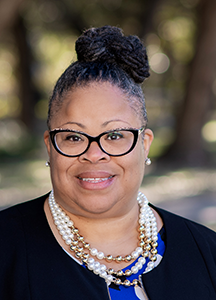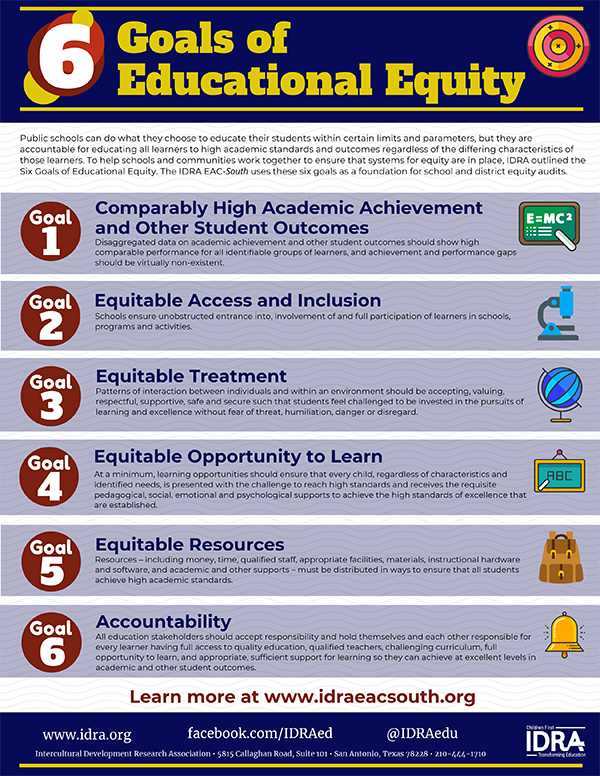• Paula N. Johnson, Ph.D. • IDRA Newsletter • April 2020 •


This article discusses the purpose, measures and outcomes of an equity audit. It showcases examples of how the information from an audit can assist schools and districts in addressing inequity.
The Role of Accountability
The Learning Policy Institute suggests that productive accountability systems acknowledge that each level of educational leadership has various responsibilities (2016). Inputs, processes and outcomes related to student achievement vary among schools, districts, and state and federal agencies. Each entity must leverage its capacity and resources appropriately to promote equity and quality education for all students.
The Every Student Succeeds Act (ESSA) is the nation’s chief law regarding public education. It holds public schools responsible for ensuring that all students receive quality instruction that will prepare them for college and career success. The law aims to safeguard educational opportunities for students who are historically undeserved, including students of color, students in poverty, English learners and students in special education. Equity audits guide schools in conducting a critical review of their data to inform ways of addressing systemic inequities.


Goal 1: Comparably high academic achievement and other student outcomes for all groups of learners, as evidenced by disaggregated data.
Goal 2: Equitable access and inclusion that affords all learners unobstructed entrance and participation in academic and extracurricular activities.
Goal 3: Equitable treatment in a welcoming and inclusive learning environment.
Goal 4: Equitable opportunity to learn in an academic setting with high standards that offers a strong system of supports.
Goal 5: Equitable resources that include fair allocation of funding, staffing, facilities, instructional materials and equipment.
Goal 6: Accountability that assures all stakeholders hold themselves and each other responsible for the success of every student.
IDRA operates the IDRA EAC-South, which is the federally funded equity assistance center that provides technical assistance to state education agencies and school districts in 11 states in federal Region II and Washington, D.C. (covering most of the U.S. South).
The IDRA EAC-South uses the six goals as a foundation for our equity audits. We facilitate equity “walks” in districts across the southern region of the United States. Some school districts in Alabama, Louisiana, Mississippi, Texas and Virginia now use these goals to constantly gauge their success in meeting the needs of each student.
The Purpose of an Equity Audit
The goal of an equity audit is to identify institutional practices that produce discriminatory trends in data that affect students. Schools and districts conduct audits to analyze data in three key areas: programmatic equity, teaching quality equity, and achievement equity (Skrla, McKenzie & Scheurich, 2009).
Below are examples of guiding questions related to each of the three areas of equity. These questions help school leaders find areas of concern that may require further investigation.
Programmatic Equity
- Which population groups are underrepresented in Advanced Placement classes or honors classes?
- Which groups are overrepresented or underrepresentation in special education classes?
- Which groups are disciplined more often and more severely than other groups?
Teaching Quality
- Are the most experienced teachers teaching the students with the greatest needs?
- Are most of the new teachers teaching in the schools with the greatest needs?
- Are there certain schools where there is high teacher mobility? Why?
- Are teachers in the high needs areas, like special education and bilingual education, certified?
Achievement Equity
- Where are the achievement and opportunity gaps among population groups based on the state assessment exam at each grade level?
- Which population groups are graduating at lower rates than others?
- Which students are being retained in grade?
- Which students are dropping out of school?
When the IDRA EAC-South facilitates equity audits with district teams, we work together to discover the institutional changes that will ensure equitable, diverse and inclusive environments for all learners.
Data Collection and Review
An equity audit requires input from stakeholders across a school district. Schools collect data in many forms to provide them with a wide range of influences that contribute to student achievement. Data collection can come from a variety of sources, including:
- Listening sessions with district leadership;
- Classroom and campus observations;
- Focus group interviews with teachers, students and parents;
- Reviews of school discipline policies and code of conduct;
- Information provided on the campus or district website;
- School climate surveys;
- Student graduation, attrition and retention reports; and
- State report cards and assessment data.
Several student characteristics help tell the story of school data. These include race, gender and gender identity, family income, national origin, special education, and disability. Data indicators for student achievement include graduation, in-grade retention and attrition rates (for students and teachers); discipline rates; advanced placement, honors and advanced course enrollment; extracurricular participation; and family and community engagement and leadership.
The Product of an Equity Audit
Equity audits guide schools in answering several questions: What supports do students need at each intersection? How well is the district providing these supports? Which students are disengaged? Where can the district improve? An audit has the power to confirm equity concerns and bring new ones to light.
IDRA EAC-South staff review the results of each of its school’s equity audit with the district team. We provide district leadership with recommendations that outline a plan for technical assistance as needed. IDRA EAC-South staff work together with district staff to draft an agreement that details intervention goals, timelines and targets.
Equitable Education Outcomes for All Students
Achieving educational equity begins by initiating some uncomfortable conversations about relevant data: the good, the bad and the ugly. “Systemic equity can only be created in an environment that embraces a set of underlying assumptions about the right of every learner to receive the best possible public education” (Scott, 2001).
Equity audits provide schools and districts with clear indicators for how well they are meeting the needs of their students and which areas need more attention.
IDRA EAC-South can be a free technical assistance resource to schools in the U.S. South. Contact the IDRA EAC-South or visit https://www.idra.org/eac-south for more information.
Resources
Darling-Hammond, L., Bae, S., Cook Harvey, C.M., Lam, L., Mercer, C. Podolsky, A., & Stosich, E.L. Pathways to New Accountability Through the Every Student Succeeds Act (Palo Alto: Learning Policy Institute, 2016).
IDRA. (2019, August 7). Equity Audits – Assessing Equity Across Education, IDRA Visiting Scholar Webinar Series. San Antonio, Texas: Intercultural Development Research Association.
IDRA. (2017). Six Goals of Educational Equity and School Reform – The Equity Ranking Scale. San Antonio, Texas: Intercultural Development Research Association.
IDRA. (2006). Six Goals of Educational Equity, webpage. San Antonio, Texas: Intercultural Development Research Association.
Scott, B. (February 29, 2008). “Six Goals of Educational Equity,” IDRA Classnotes Podcast Episode 29.
Scott, B. (March 2001). “Coming of Age,” IDRA Newsletter.
Scott, B. (January 1995). “The Fourth Generation of Desegregation and Civil Rights,” IDRA Newsletter.
Skrla, L., McKenzie, K.B., Scheurich, J.J. (2009). Using Equity Audits to Create Equitable and Excellent Schools. Thousand Oaks: Corwin Press.
Paula N. Johnson, Ph.D., is a IDRA senior education associate and director of the IDRA EAC-South. Comments and questions may be directed to her via email at paula.johnson@idra.org.
[©2020, IDRA. This article originally appeared in the April 2020 IDRA Newsletter by the Intercultural Development Research Association. Permission to reproduce this article is granted provided the article is reprinted in its entirety and proper credit is given to IDRA and the author.]


